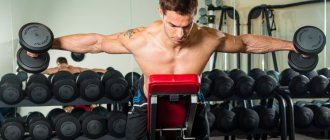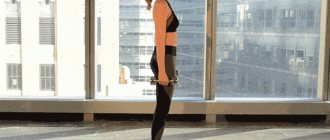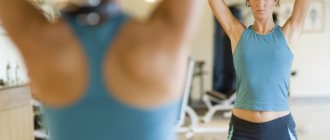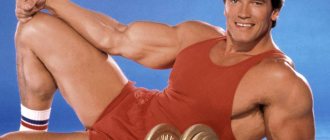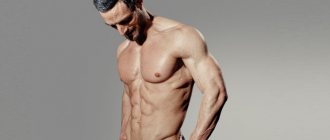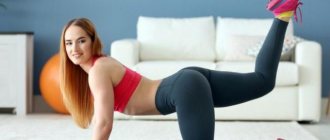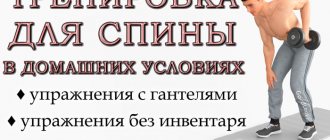You must decide how many days to train, which muscle groups to train on which days, which exercises to perform, how many sets and reps to perform, how to increase (progress) the load, and so on.
It's no wonder that so many people find this whole process too confusing, and so often choose the simplest option: full body training.
Most involve just a few exercises, don't take too much time, and work every major muscle group in the body.
What is fullbadi training and its features
Translated from English, “full body” literally means “whole body,” which is what her technique says - working out the whole body in one workout.
Typically, trainers recommend this type of training for beginners, that is, people whose muscles and ligaments are not yet ready for intense power loads. Thanks to performing 2 exercises per muscle group, and not 4-6, as in split training, untrained muscles do not overwork and have time to recover without receiving excessive microtrauma.
Recent studies have confirmed that such training 2-3 times a week helps to get and maintain excellent physical shape, without excessive strength loads, but this will take a little more time.
Also, this training method is suitable for girls, taking into account the characteristics of the female body, for which it is better to perform a couple of exercises on the legs in each workout, supplementing the program with exercises that involve all the muscles of the body at one time.
An important feature of the training is that the program consists mainly of multi-joint exercises, which are also called basic. In such exercises, at least two joints are simultaneously worked, and isolating exercises are included in the program less frequently.
Rules for creating a program and types of exercises
If you need to create a program yourself and generally understand its principle, follow these simple rules:
- During one workout, one muscle group should perform no more than three exercises.
- The program should consist of 6 main exercises, one exercise from each type, namely:
- Hip-dominant - the main or dominant is the hip joint, such exercises include deadlifts and Romanian deadlifts, hyperextensions and the like.
- Knee-dominant - that is, the knee joint is dominant, namely in exercises such as squats, lunges and the like.
- Horizontal presses are exercises such as push-ups and all kinds of barbell and dumbbell presses at different angles.
- Vertical presses - namely standing presses and exercises that turn the shoulder outward, such as pull-downs and dumbbell lateral raises.
- Vertical rows – these include all types of pull-ups and vertical block rows.
- Horizontal rows are rows of barbells and dumbbells in a bent position, as well as rows of blocks in a horizontal position.
- You can optionally add 1-2 exercises for biceps, triceps or lower legs.
- At the end of the complex, 2-3 exercises are performed on the abdominal muscles; select any techniques according to the degree of difficulty; they do not have to be changed every workout, unlike the main part.
- On average, 2-4 approaches are performed in each exercise, it all depends on the preparation.
- The training duration is no more than one hour.
- It is necessary to perform 3 workouts per week - 1 microcycle, but no more than 4 workouts, preferably every other day.
- At the beginning of the training, the most difficult exercises of the first type should be performed - knee- and pelvic-dominant, number one and two. Each subsequent set should consist of easier exercises, with the easiest ones at the end.
- Rest between sets averages 2 minutes.
- Each week, try to reduce the number of repetitions by adding more weight. For example, the first week - 20,15,12,10 repetitions, the second week - 15,12,10, 8, the third - 12,10,8,6, the fourth - 10,8,6,4.
Examples of exercises that can be added to a training program
Knee-dominant
- Squats.
- Squats with dumbbells.
- Lunges of all kinds.
- Farmer's walk.
- Front squats.
- Hack machine.
- Squats in Smith.
- Lunges in Smith.
- Sumo squats.
- Leg extension.
Pelvic-dominant
- Deadlift.
- Romanian cravings.
- Hyperextension.
- Swing your legs in a simulator and crossover.
- Leg bending in the simulator.
Horizontal presses
- Bench press with a barbell.
- Press with a barbell at an angle of 30 and 45 degrees.
- Close grip press.
- Pushups.
- Reverse push-ups.
- Horizontal press with dumbbells.
- Incline dumbbell press.
- Dumbbell flyes lying horizontally and at an angle.
Vertical rods
- Wide grip pull-ups behind the bar.
- Pull-ups to the chest.
- Reverse grip pull-ups.
- All types of vertical block rods.
Vertical presses
- Standing dumbbell press.
- Barbell press or overhead Smith.
- Barbell press or Smith press in front of you.
- Arnold press.
- Dumbbell raises to the sides.
- Barbell row to the chin.
- Front swings.
Horizontal rods
- Horizontal block row with a narrow and wide grip (rear delta).
- Bent-over barbell row.
- Bent-over dumbbell rows.
- Row of one dumbbell in support.
- Lever rod.
- T-bar.
- Pull-ups on a low bar or with TRX.
Of course, it would be correct if at the end of the blocks you add isolating exercises for the biceps, triceps and lower legs, so look at your well-being and muscle development.
Triceps
- Triceps in the upper block of the crossover.
- Extension of arms with dumbbells from behind the head.
- One-arm dumbbell extension from behind the head.
- Extension of the crossover block from behind the head.
- Bent over arm extension with dumbbells.
- French press.
Biceps
- Curling arms with a barbell with various grips.
- Curling arms with dumbbells - together or alternately.
- Curling arms with dumbbells in supination.
- Hammer.
- Concentrated dumbbell lift.
- Bending arms from the lower block of the crossover.
- Bending arms in the simulator.
Shin
- Shin in a sitting machine.
- Donkey.
- Calf raise in Smith.
- Calf raise with dumbbells on one leg.
Read more about the calf raise exercise →
Press
- Crunches on the floor – full and short.
- Crunches on a bench and a Roman chair.
- Lying leg raises.
- Hanging leg raises - on uneven bars or a crossbar.
- Bike.
- Diagonal twists in all variations.
- Crunches in a block machine.
- "Prayer" in a crossover.
At the end of the workout, you can do ten minutes of cardio to cool down and be sure to stretch all the muscles of the body after the exercise.
Rules for creating a training program
Fulbadi or fullbody training, aimed at all muscle groups in the body, must be designed correctly. To achieve results, it is important to follow a few simple principles and rules:
- There should be no more than three exercises for each muscle group in one session. The training is aimed at thoroughly working out the areas, and not at creating the effect of overtraining.
- The training program consists of 6 exercises of several types: pelvic-dominant, knee-dominant, horizontal presses, vertical presses, vertical rows, horizontal rows.
- If desired, you can supplement the training program with several exercises to work the lower leg, biceps or triceps.
- At the end of each lesson, you need to perform 2-3 abdominal exercises. Depending on the level of physical fitness, we select the appropriate degree of difficulty. Unlike the main, basic part, these exercises do not need to be changed - they complement the program.
- The optimal number of approaches for each exercise is 2-4. We take into account the level of physical fitness.
- The duration of one lesson according to the Fulbadi program should not exceed 60 minutes. This time is enough to achieve your goals.
- The optimal number of workouts per week is 3. It is advisable to leave one day between classes for muscle recovery and preparation for the next one.
- The system of performing exercises is built as follows - first we do complex elements, then move on to simple ones.
- Break/rest between approaches – no more than 2 minutes.
Pros and cons of fullbadi
The following benefits of training can be highlighted:
- The training is suitable for beginners and is correct for an unprepared body, as well as for regaining shape after a long rest and subsequently rehabilitation after injuries.
- The workout is suitable for both men and girls.
- Fulbadi is also suitable for professional bodybuilders in the off-season to maintain shape after competitions.
- An ideal workout for women of all ages.
- Thanks to adequate load, each muscle is trained properly, but is not unnecessarily injured, having time to recover for the next workout.
- The risk of overtraining and the development of severe inflammation in the muscles the next day is reduced.
- Better for beginners than a split system.
- Allows you to strengthen muscles and also get rid of excess fat.
- A safer method for strengthening ligaments and muscles.
Flaws:
- Although this is not a disadvantage, this method is still not suitable and ineffective for experienced gym goers who require complex split training to progress.
- Despite the fact that the training is designed for beginners, it is still not worth doing it in the first month, since it is not advisable for unprepared people to perform complex basic exercises.
Scheme No. 1: split
The most popular scheme, chosen by 80% of bodybuilders. The principle of the scheme is elementary: the body is divided into 3 parts, and on a certain day their muscle groups are trained. For example:
- Monday: legs + abs;
- Wednesday: back + shoulders;
- Friday: chest + biceps + triceps.
If you divide the body into top and bottom, this will also be called a split, but not in its classical sense. With this approach, the athlete alternates training of the upper and lower parts of the body, exercising every 2 days.
The point is to maximally load each muscle and allow maximum time for recovery. While one group is working, everyone else is resting. But not everything is so simple: there are two details that, if handled incorrectly, can ruin everything.
Processing order
When creating a split, it is important to understand which muscle should be worked on in each subsequent session. The fact is that large muscle groups function in tandem with small ones. For example:
- Bench press. The main load falls on the pectoral muscles, the additional load falls on the triceps.
- Pull-ups. The main load is the latissimus dorsi, additional load is the forearm and biceps.
- Deadlift and squat. Works the buttocks, leg muscles and back extensors.
Let's imagine that on Wednesday you did a great workout on your pecs and biceps, and on Friday you plan to work on your back and triceps. But by Friday the arms will not be able to fully recover, so pull-ups will be unproductive. The biceps and forearm simply will not allow you to load your back as much as possible, as they will quickly turn off.
Fullbody program for men
Perform 3-4 sets of each exercise, 15,12,10, 8 reps, rest for two minutes between sets. During the period of performing the first two exercises of the complex, you can rest until complete recovery.
Day 1
- Squats.
- Leg bending in the simulator.
- Horizontal barbell press.
- Pull of the upper block behind the head.
- Pull a horizontal block to the belt.
- Standing dumbbell press.
- Shin sitting.
- Press – any two exercises.
Day 2
- Sumo squats.
- Romanian cravings.
- Wide grip pull-ups to the bar.
- Row of one dumbbell to the belt in support.
- Dumbbell press at a 45 degree angle.
- Dumbbell raises to the side.
- Medium grip barbell curl.
- Press.
Day 3
- Front squats.
- Deadlift.
- Close grip barbell press.
- Pull a vertical block in front of you.
- Wide grip horizontal block row – rear deltoid.
- Smith press in front of you with a medium grip.
- Curling arms with dumbbells in supination.
- Press.
Fullbody workout for women
First day
| exercise | quantity |
| barbell squat | 3 x 10-12 |
| lunges with dumbbells in hands on each leg | 4 x 10-12 |
| push-ups with wide arms | 2 x 12-15 |
| lifting the arms with the barbell to the chin (dumbbell option) | 3 x 10-12 |
| lifting the legs to a right angle on a block with emphasis on the hands (lifting while lying on the mat) | 3 x 10-12 |
| triceps extension with dumbbells behind the head | 3 x 10-12 |
Second day
| exercise | quantity |
| plie squat with dumbbell | 3 x 10-12 |
| roman bar deadlift | 3 x 10-12 |
| lifting dumbbells overhead while sitting | 3 x 10-12 |
| hyperextension (lifting the body while lying on the stomach) | 3 x 8-10 |
| dumbbell curls | 3 x 10-12 |
| bar | 3 x 20-30 seconds |
Like men, girls are also advised to gradually increase the load over time.
Let's move smoothly
Fulbadi program for girls
Perform 2-3 sets of each exercise for 15-20 repetitions with light weight.
Day 1
- Smith machine squats.
- Scissor lunges.
- Dumbbell bench press.
- Pull of the upper block behind the head.
- Pull-ups on a low bar.
- Seated dumbbell press.
- Lying crunches.
- Lying leg raises.
Day 2
- Leg press.
- Deadlift with dumbbells.
- Smith machine press at a 45 degree angle.
- Pull the upper block in front of you.
- Pull a horizontal block to the belt.
- Dumbbell raises to the side.
- Lying crunches.
- Lying leg raises.
Day 3
- Extension of the lower leg in the simulator.
- Hyperextension.
- Lying dumbbell flyes.
- Reverse grip lat pulldown.
- TRX pull-ups.
- Close grip barbell press.
- Hammer.
- Lying crunches.
- Lying leg raises.
